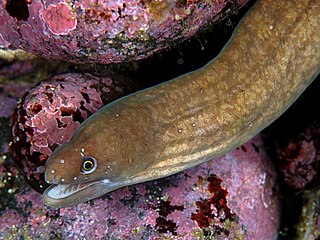
Anarchias is a genus of moray eels in the family Muraenidae.

The fangtooth moray sometimes also known as tiger moray or bird-eye conger is a moray eel of the family Muraenidae found in warmer parts of the eastern Atlantic Ocean, including the Mediterranean Sea, Canary Islands, Madeira and various other islands.

Anarchias allardicei is a moray eel commonly known as the Allardice's moray. It is light brown in color, and is found in coral reefs in the Pacific and Indian Oceans.
Anarchias cantonensis is a moray eel commonly known as the Canton Island moray or the Canton moray. It was first named by Schultz in 1943 and is found in coral reefs in the Pacific and Indian Oceans.
Anarchias galapagensis is a moray eel commonly known as the Minute moray or the Hardtail moray. It was first named by Alvin Seale in 1940 and is found in coral reefs from the Gulf of California to Colombia. At a maximum length of 14 cm, it is regarded as one of the smallest morays worldwide.
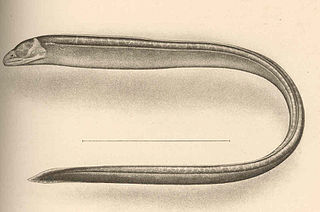
Anarchias leucurus is a moray eel found in the Pacific Ocean. It was first named by Snyder in 1904 as Uropterygius leucurus, and is commonly known as Snyder's moray, the fine-spotted moray or the finespot moray. It is thought to be the smallest species of moray, and may actually represent several different species or subspecies.
Anarchias longicaudis is a moray eel found in the eastern-central Atlantic Ocean. It was first named by Peters in 1877.

Anarchias seychellensis is a moray eel found in coral reefs in the Pacific and Indian Oceans. It was first named by J. L. B. Smith Smith in 1962, and is commonly known as the Seychelles moray or the marbled reef-eel.
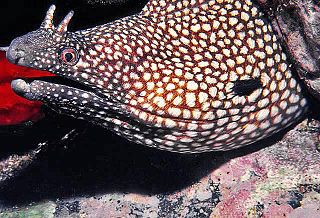
Muraena pavonina is a moray eel that occurs in the western and eastern Atlantic Ocean. It is found in holes and crevices at depth 2–60 m. This species has a maximum length of 51.2 cm (20.2 in).
Muraena robusta is a moray eel found in the eastern and central Atlantic Ocean. It reaches a maximum length of 150 centimeters, or roughly 5 feet. It is commonly known as the stout moray.

The dark moray eel is a moray eel found in the eastern Atlantic Ocean, from Mauritania to Cape Frio, Namibia. It was first named by Marcus Elieser Bloch in 1795,.
The lichen moray is a moray eel found in the western Atlantic Ocean, around eastern Florida, the Bahamas, and Cuba. It was first named by Böhlke and Böhlke in 1977.
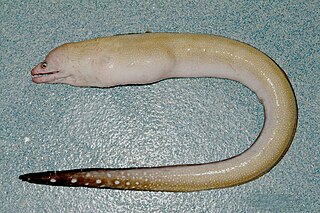
The blacktail moray eel is a moray eel found in the western Atlantic Ocean. It was first named by Böhlke and Böhlke in 1980.
The spotjaw moray is a moray eel found in the eastern Atlantic Ocean. It was first named by Max Poll in 1953.

Gymnothorax ocellatus is a moray eel found in coral reefs in the western Atlantic Ocean. It was first named by Louis Agassiz in 1831, and is also commonly known as the blackedge moray, Caribbean ocellated moray, conger, ocellated moray, spotted moray, sawtooth moray, white-spotted moray, or yellow cong.

The brown moray eel, Gymnothorax unicolor, is a moray eel found in the eastern Atlantic Ocean and Mediterranean. It was first named by Delaroche in 1809.
Anarchias exulatus is an eel in the family Muraenidae. It was described by Joshua S. Reece, David G. Smith, and Erling Holm in 2010. It is a subtropical, marine eel which is known from the Hawaiian Islands, Johnston Atoll, Rapa, Gambier, Pitcairn Island, and the Tonga Islands. It is an uncommon species which dwells in coral reefs and rocky regions near shores, and has been reported at a depth of 12 metres. Males are known to reach a maximum total length of 29.3 centimetres.
Anarchias schultzi is an eel in the family Muraenidae. It was described by Joshua S. Reece, David G. Smith, and Erling Holm in 2010. It is a tropical, marine eel which is known from the western Pacific Ocean, including the Caroline Islands, the Solomon Islands New Caledonia, and the Tonga Islands. It is an uncommon species which dwells at a depth range of 8–14 metres, in coral reefs and rocky regions near shores. Males are known to reach a maximum total length of 15.9 centimetres.
Anarchias supremus is an eel in the family Muraenidae. It was described by John E. McCosker and Andrew L. Stewart in 2006. It is a subtropical, marine eel which is known from Macauley Island on the Kermadec Ridge in the southwestern Pacific Ocean. Males are known to reach a maximum total length of 19.1 centimetres.
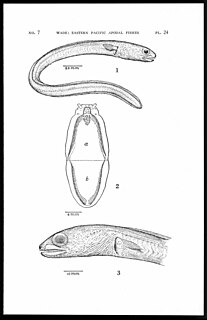
The shorttail conger is an eel in the family Congridae. It was described by Charles Barkley Wade in 1946, originally under the genus Chiloconger. It is a subtropical, marine eel which is known from the eastern and southeastern Pacific Ocean, including Costa Rica, Ecuador, El Salvador, Guatemala, Honduras, Mexico, Nicaragua, the Galapagos Islands, Panama, and Revillagigedo. It dwells at a depth range of 108–150 metres. Males can reach a maximum total length of 30 centimetres.










